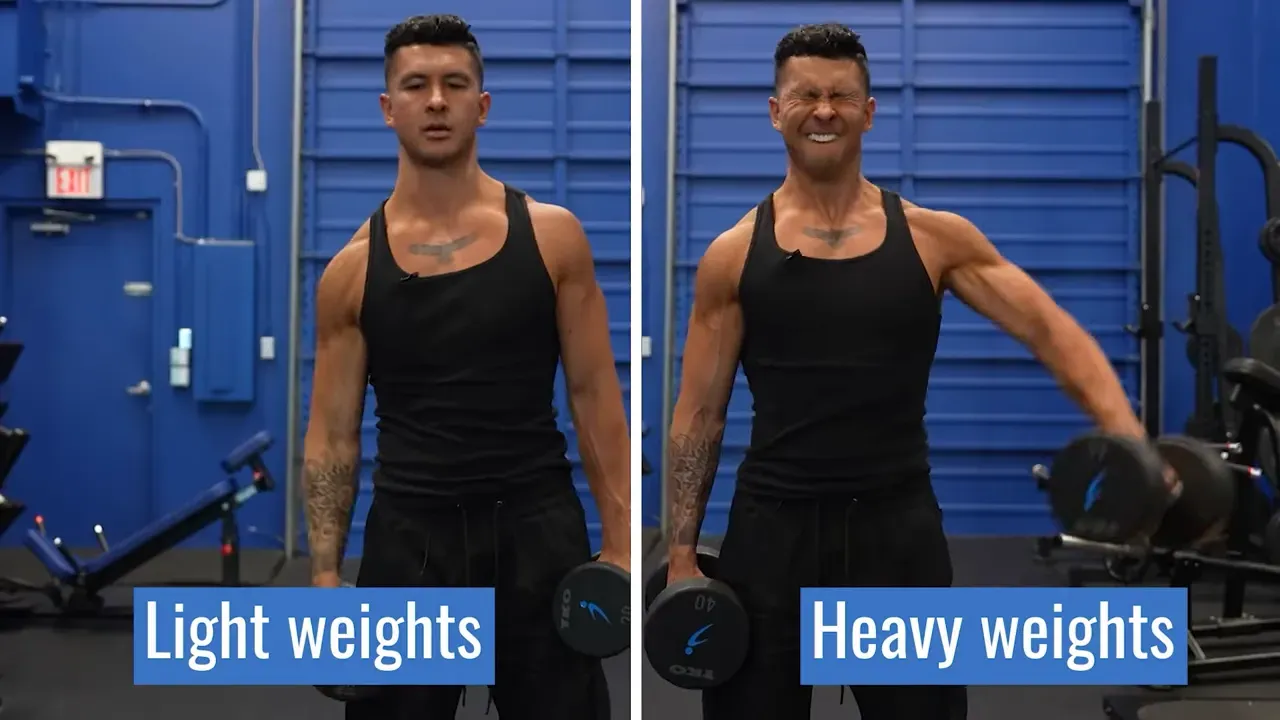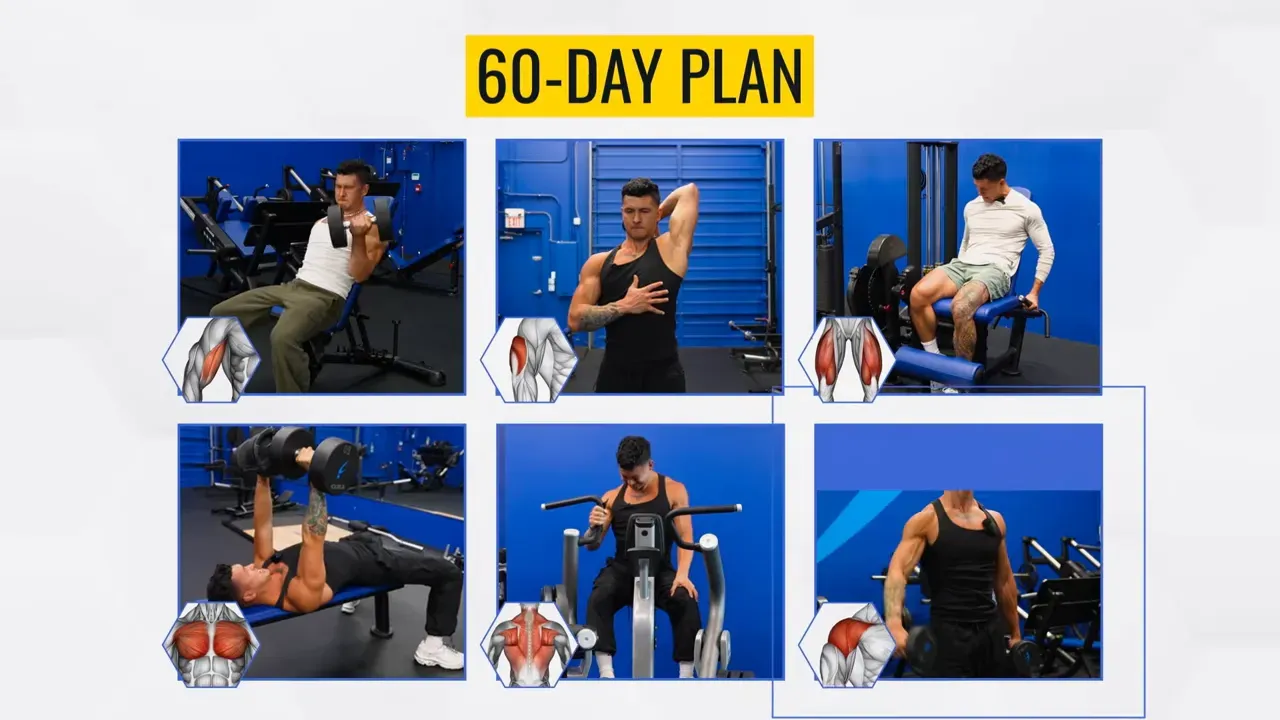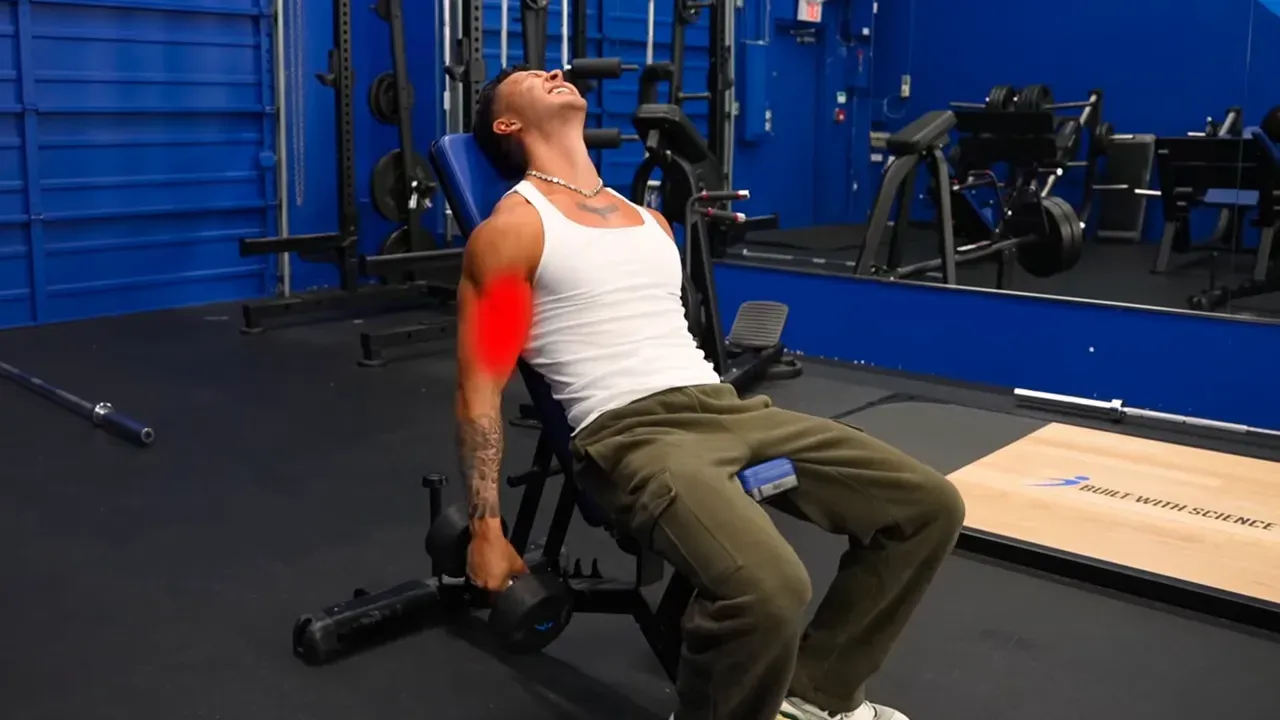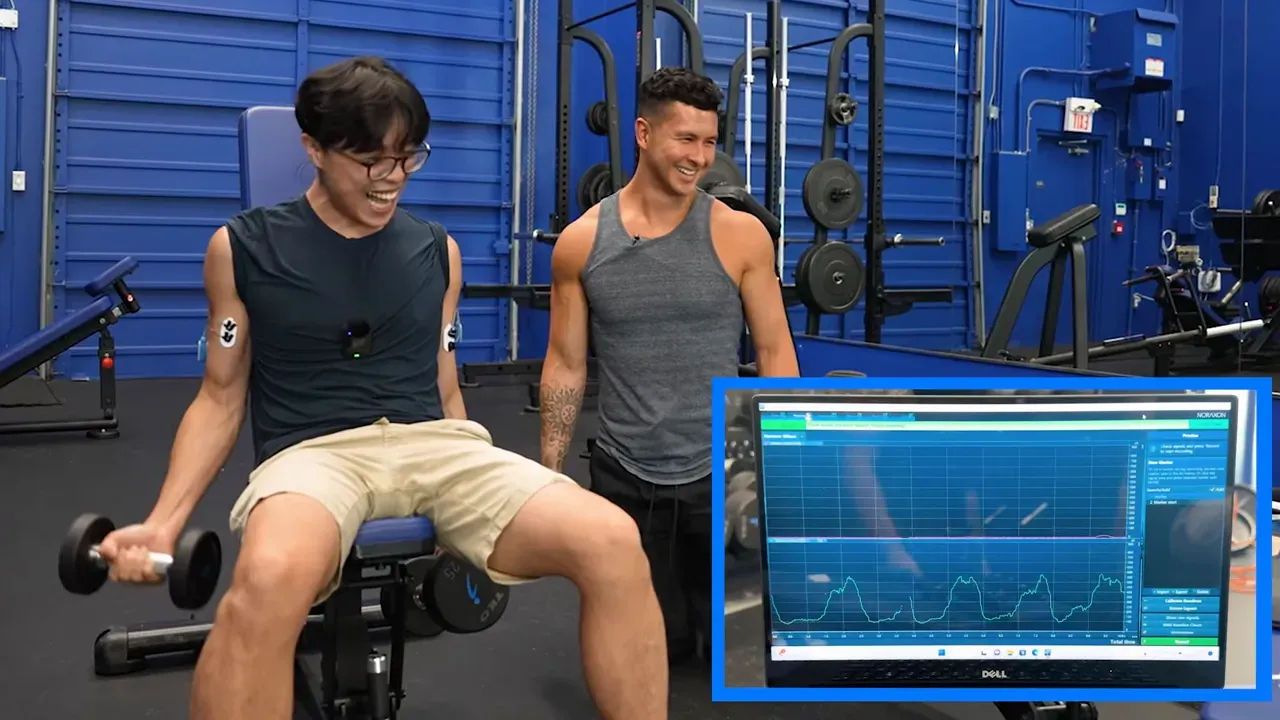Heavy vs Light Training for Muscle Gain: 60-Day Experiment
Delve into Jeremy Ethier’s experiment and find out how you can use proven strategies to grow muscle and boost strength safely.

Key takeaways
- You can build similar muscle with light or heavy loads if you push near failure each set.
- Your strength gains depend on the rep range you train; heavy = strength, light = endurance.
- You must manage joint stress and form—mix 6–15 reps for best muscle and less pain.
Try this today
✓ Pick one compound exercise and do 3 sets at 6–12 reps with controlled form. Focus on effort, not ego.
Want to build more muscle, lose fat, and improve your physique with smarter choices, not more guesswork?
In this expert review, we analyze, critique, and expand on Jeremy Ethier's 60-day unilateral heavy vs light training experiment.
What makes this review different?
- Carefully reviewed and fact-checked by experts
- Little-known tips to preserve joints and force progressive overload with light loads
- Complete workout plan inspired by the balance between heavy strength work and high-rep volume
Why should you listen to us? We've published 300+ articles, all rigorously reviewed by an exercise scientist with 25+ years of real-world training experience.
Keep reading for a practical breakdown, a program you can use, expert commentary, and specific steps you can implement this week.
In a Nutshell: heavy vs light for growth
You can grow muscle with heavy loads or light loads if you take sets near failure and keep progressive overload. You must, however, manage joint stress and training variety. In Jeremy Ethier’s controlled 60-day test, the light side showed a hair more growth overall, but differences were tiny and within measurement error. Strength went to the heavy side; endurance and pump favored the light side. You should aim to train mostly in a middle ground (6–15 reps) and sprinkle heavy and light work.
Key concepts
- Failure-driven hypertrophy: Take sets close to failure to maximize fiber recruitment.
- Endurance vs strength adaptation: Low reps build force capacity; high reps build work capacity.
- Joint stress trade-off: Heavy loads strengthen tendons but can aggravate joints when misapplied.
How Jeremy tested it — A practical breakdown
The experiment design
Jeremy split his body in half. One side trained heavy (3–6 reps to failure). The other side trained light (15–30 reps to failure). Each major muscle was trained unilaterally. Each side received the same number of sets. Every set was taken as close to failure as possible.

This design isolates load as the primary variable. It also forces you to confront two practical issues: volume and effort. Light work produces more total reps and time under tension, often much higher weekly volume. Heavy work requires fewer reps and less time, but higher force per rep.
Baseline measurements and why they matter
Jeremy used high-quality measurements: full-body MRI, DEXA, ultrasound, and circumferences. MRI is expensive but precise. DEXA gives lean mass and fat. Ultrasound and circumferences provide cross-checks. That multi-method approach reduces false positives due to one method’s measurement error.
If you test a training method, you need consistent, precise measurement. Otherwise you risk reading noise as a real change.
Training details you should notice
- Unilateral focus: one arm/one leg at a time improved isolation of effects.
- Equal sets per side: keeps volume matched in set count but not in total tonnage.
- Failure rules: heavy side reached failure within 3–6 reps; light side within 15–30 reps.
- Nutrition: both trained in a small calorie surplus to allow growth.

Week 1–2: early sensations and volume surprise
You feel two things immediately. Heavy sets are hard from the first rep. They recruit big motor units fast. Light sets start easy and then become painful around rep 15–20 due to metabolic stress. Jeremy noted that weekly tonnage (sets × reps × load) was far higher on the light side. In one week the light side totaled over 100,000 lb lifted; heavy side was about half.
That surprised him and those watching. If total volume were the only driver of hypertrophy, light work would dominate. But hypertrophy is multifactorial: tension, volume, fiber recruitment, metabolic stress, and recovery all matter.
Midway: pump, fatigue, and adaptation
The light side gave a massive pump. Jeremy and his test subject, Dennis, felt the muscle swell. Pump comes from blood and fluid trapped in the muscle during high-rep work and short rests. It looks and feels satisfying. It also may signal growth via cell swelling. But evidence is mixed. Many pump-focused tricks don't lead to more long-term growth unless effort and progressive overload continue.
Practical point for you: the pump can motivate consistency. But don't mistakenly equate pump with superior long-term growth unless you keep progressive overload.

Strength vs endurance — The split outcome
By week six the heavy side had obvious strength gains. Dennis was lifting far more weight on the heavy side. Yet the light side improved endurance and tolerance to metabolic burn. Jeremy tested both sides with weights from each side at day 60. Each side faltered when switched to a loading pattern they hadn't trained. Strength gains did not fully transfer immediately across rep ranges.
Why? Because strength is a neural skill and a force-producing capacity. Low-rep heavy work trains nervous system coordination, synchronous motor unit recruitment, and intramuscular coordination. High-rep work trains mitochondria, buffering capacity, and pain tolerance.
Injuries and joint stress — The real cost
Jeremy experienced knee and elbow irritation on heavy work. Heavy loads place high compressive and tensile forces on joints and tendons. Over time, that builds tendon strength. But if you push heavy too often on poorly-chosen movements or with small stabilizing muscles unprepared, pain can appear.
Jeremy switched some heavy isolation work to lighter, joint-friendly options. That’s a smart move you should copy: prioritize long-term joint health over short-term ego lifts.
Endurance adaptation test
After sustained high-rep training, Jeremy’s heavy side failed earlier when tested at high reps. The light-trained side showed greater endurance when switching to lighter weight for high reps. That’s endurance adaptation: more mitochondria, better buffering, and higher pain tolerance. It’s a neural and cellular adaptation.
EMG and fiber recruitment insight
Jeremy used EMG to show muscle activation patterns. Heavy sets produced high activation from the first rep. Light sets started lower and climbed toward failure. The issue is this: large fast-twitch fibers (type II) contribute most to thicker, visible gains, but they only get fully recruited if you produce enough force or push small fibers into fatigue until large ones recruit. If you stop short because of burn, you’ll under-recruit those big fibers. That explains why many people doing moderate weight high reps never add substantial size.

Day 60: the scans and what they really show
Jeremy gained ~2 lb total. About 0.6–0.7 lb was muscle. The light side showed a tiny edge in most muscles. The chest had double the growth on the light side, possibly because Jeremy had not trained chest with such high reps before. But the absolute differences were tiny — sometimes as low as 15 g. Both ultrasound and circumferences agreed: differences were within measurement error.
Bottom line: muscle mass gains were effectively equal between heavy and light when sets were taken near failure and nutrition allowed growth. Strength differences were clear: heavy training produced greater low-rep strength; light training produced more endurance.
Unexpected imbalance and the cost
MRI revealed one deeper muscle (the iliopsoas) grew more on the heavy side and shrank on the other. After the experiment, Jeremy resumed heavy deadlifts and tweaked his back. The unilateral heavy workload likely created a stabilization imbalance. That’s a practical warning: extreme unilateral loading can alter stabilizer development and create asymmetry that affects movement patterns.
Heavy & light hypertrophy program
This program is built on the practical insight from Jeremy’s test: effort matters more than load, but rep ranges shape the adaptation. The plan prioritizes 6–15 reps most of the time. It uses unilateral work to fix imbalances and includes heavier and lighter days to provide neural and metabolic stimuli.
Program overview
- Ideal for: intermediate lifters wanting muscle and less joint pain.
- Equipment needed: barbell, dumbbells, a rack, cables, leg press or split squat setup.
- Duration: 8 weeks cycle with deload week at week 5 or 6 if needed.
Workout
Typical week: 4 training days (Upper/Lower split). Each session has a heavy compound focus and several accessory lifts in 6–15 reps. Include one high-rep finisher per muscle 1x week (15–25 reps) for metabolic conditioning.
Day A — Upper (Horizontal push/pull focus)
- Barbell bench press — 4 sets × 6–8 reps — rest 2–3 min
- One-arm dumbbell row — 4 sets × 8–12 reps — rest 1.5–2 min
- Incline dumbbell press — 3 sets × 8–12 reps — rest 1.5–2 min
- Face pulls — 3 sets × 12–15 reps — rest 60–90 sec
- Biceps curl (preacher/DB) — 3 sets × 8–12 reps
- Triceps overhead extension (light if elbow bothers) — 3 sets × 10–15 reps
Pro tips:
- Start with a heavy compound done with controlled tempo and full range.
- Use unilateral rows to keep left-right balance in check.
- If elbows hurt on heavy overhead, switch to pushdowns or close-grip bench with lighter load.
Day B — Lower (Hinge and unilateral focus)
- Barbell deadlift or trap-bar — 4 sets × 4–6 reps (heavy day)
- Bulgarian split squat (unilateral) — 4 sets × 8–12 reps each leg
- Leg press or hack squat — 3 sets × 8–12 reps
- Hamstring curl (seated) — 3 sets × 10–15 reps
- Calf raises — 4 sets × 10–20 reps
Pro tips:
- Use split squats to even out unilateral imbalances.
- Monitor knee and hip pain on heavy leg extensions. Avoid if painful.
- If deadlifts cause low-back strain, reduce load and increase reps or use deficit/paused variations.
Day C — Upper (Vertical and accessory)
- Seated dumbbell overhead press — 4 sets × 6–10 reps
- Lat pulldown or pull-ups — 4 sets × 6–12 reps
- Chest-supported row — 3 sets × 8–12 reps
- Lateral raises — 3 sets × 12–15 reps
- Hammer curls — 3 sets × 10–12 reps
Pro tips:
- Keep shoulder press within pain-free range and use moderate reps if you have impingement history.
- Use controlled tempo on lateral raises to minimize momentum.
Day D — Lower (Volume and metabolic focus)
- Front squat or weighted goblet — 4 sets × 6–10 reps
- Romanian deadlift — 4 sets × 8–12 reps
- Walking lunges — 3 sets × 12–20 steps
- Leg curl drop sets — 3 sets × 12–25 reps
Pro tips:
- On the high-rep finishers, focus on time under tension and slow eccentrics.
- Use unilateral lunges to address strength discrepancies.
Notes on Program Execution
- Progressive overload is mandatory. Increase weight when you hit the top of rep ranges with good form.
- Use 6–15 reps as the core range. Add 1 heavy set (3–6 reps) and 1 high-rep set (15–25 reps) weekly for variation.
- Monitor joints. If a movement causes pain, swap or lower the load.
- Nutrition: aim for a small calorie surplus (+250–350 kcal) and 0.8–1.0 g protein per lb bodyweight.
Two closing paragraphs on the program: This plan blends the best of both approaches. You get the neural drive and fiber recruitment from heavy sets. You get metabolic conditioning and higher weekly volume from moderate-to-high rep work. Use unilateral lifts to correct imbalances and stop chasing numbers at the expense of form. Treat pain as a warning sign, not a rite of passage.
Want to automate workouts like that and more? Put your progress on autopilot with Dr. Muscle AI.
Expert Corner: Proven Strategies & Hidden Gems
Practical Applications
- Use failure strategically: Take key sets within 1–2 reps of failure to recruit larger fibers. For isolation, stop 1–2 reps shy to avoid tendon overload.
- Apply targeted unilateral work weekly: If you see a side-to-side asymmetry, add 2–4 unilateral sets per week for the weaker side, not the stronger one.
- Mix rep ranges across weeks: Use a weekly undulating approach—heavy day (3–6), medium day (6–12), light day (12–20)—to produce varied stimuli.
Examples:
- Example 1: Replace one heavy bilateral squat set with unilateral split squats for the weaker leg to fix squat imbalances.
- Example 2: If elbows flare up on heavy skullcrushers, swap to rope pushdowns at 10–15 reps and keep heavy bench variations elsewhere.
Fact-Check of Key Points
- "Recent studies suggest it's possible [to build muscle with light loads]" — Accurate: evidence shows hypertrophy can occur across a broad range of loads when sets are taken near failure, but load influences strength and neural adaptation.
- "Total volume on the light side exceeded 100,000 lb versus half that for heavy" — Correct as reported. But tonnage alone does not capture effective stimulus since load and intensity differ.
- "The pump might give a growth advantage" — Partially supported. Cell swelling can signal anabolic processes, but the long-term hypertrophic superiority of the pump is not established universally.
- "Heavy side built more low-rep strength; light side built endurance" — Supported. Neural and contractile adaptations are rep-range specific.
- "65–92.5 lb test highlighting asymmetric carryover" — Valid observation: trained motor patterns and strength are specific and do not instantly transfer across rep ranges or to the untrained contralateral load.
More Little-Known Tips for making light loads work
- Manage progression by reps, not only by load. Add reps weekly on light days until you hit the top of the prescribed range, then increase load by 5–10%.
- Use short rests (30–60 sec) only on pure metabolic finishers. For hypertrophy work in 8–15 reps, keep rests 60–120 sec to allow quality volume.
- Tempo matters: For light sets, a slightly slower eccentric (2–3 sec) increases time under tension without adding weight.
- Pre-fatigue is useful: Pre-exhausting a muscle with an isolation movement can force larger fibers during a subsequent compound set at moderate loads.
Common Mistakes With high-rep training & How to Fix Them
- Stopping before true failure — Fix: use RIR tracking and aim for 0–2 RIR on working sets.
- Chasing weight on isolation lifts — Fix: prioritize quality range and tension. Increase reps if weight jumps break form.
- Ignoring joint signals — Fix: swap angles, adjust grips, and reduce load before you lose weeks to injury.
- Failing to progress reps on light days — Fix: set weekly rep targets and log them. Progress by reps first, then weight.
Science of Low vs. High-Load Training for Hypertrophy and Fat Loss
Research consistently shows that both low-load and high-load resistance training can build muscle when performed to failure, though high-load training has an edge for strength. Hypertrophy appears to be load-independent, while fat loss is more a function of overall energy balance and training volume rather than the load itself.
Key Findings from Systematic Reviews and Meta-Analyses
- Hypertrophy is similar across loads: Multiple reviews show that muscle growth is comparable between low-load (≤60% 1RM) and high-load (>60% 1RM) training if sets are taken to failure (Schoenfeld et al., 2017), (Lopez et al., 2020), (Carvalho et al., 2022).
- Strength favors heavy loads: High-load training consistently produces superior gains in maximal strength compared to low-load training (Schoenfeld et al., 2016), (Refalo et al., 2021).
- Fiber-type differences possible: Some evidence suggests high loads may stimulate type II fibers more, while low loads may better engage type I fibers, though findings are mixed (Grgic & Schoenfeld, 2019).
- Fat loss not load-dependent: Reviews rarely report direct fat loss differences between load schemes; instead, caloric expenditure and diet play a larger role. Training volume and total work may support fat reduction regardless of load.
Practical Applications of Science
- Both light and heavy weights can build muscle—what matters most is pushing close to failure.
- Use heavy loads if your main goal is maximal strength; use lighter loads if joint health, injury recovery, or training variety are priorities.
- For fat loss, focus on total work done and diet, not whether the load is light or heavy.
Scientific Conclusion
Muscle hypertrophy can be achieved equally well with both low- and high-load resistance training to failure, but maximal strength gains favor high loads; fat loss is determined more by energy balance and training volume than by the load used.
My Opinion on lifting heavy vs light
I think you can build solid muscle with either approach if you push hard and progress. I prefer most work in the 6–15 rep range. It hits the sweet spot between force and time under tension. It keeps your joints safer. It avoids the mental agony of endless sets past 20 reps and the joint abuse of constant maximal loads.
I disagree with extremes. If you only lift heavy, you risk overloading joints and missing metabolic adaptations. If you only train ultra-high reps, you may fail to consistently recruit and overload the largest fibers. The practical solution is variety. A base of 6–15 rep work, with occasional heavier triples and periodic 15–25 rep finishers, gives you size, strength, and endurance.
I also believe unilateral work is underrated. It fixes imbalances before they become painful asymmetries. Jeremy’s side-to-side approach exposed that risk. You should use unilateral lifts as corrective tools, not just accessory fluff.
Finally, nutrition and recovery matter. If you want growth, a small surplus and sufficient protein are non-negotiable. The training method is a stimulus; the body needs resources to respond.
Concluding on practical guidance
A common misconception is that “heavy is the only way to grow.” That’s not true. Effort is the driver. Load matters for strength. But if you take sets close to failure and keep progressive overload, light and heavy work both grow muscle. The difference is in the adaptation: heavy work produces stronger, more powerful fibers and neural gain; light work produces more metabolic conditioning and endurance.
Insider perspective: if you crave fast, large, visible gains and you can tolerate the joint stress, include heavy phases. If you want longevity and fewer aches, bias toward moderate loads and higher reps with strict form. Most lifters benefit from a hybrid approach: the middle rep ranges (6–15) do most of the heavy lifting for your physique with less wear and tear.
Final insight: your training should be a toolbox, not a single hammer. Use heavy weights to build force. Use moderate-to-high reps to accumulate safe volume. Fix imbalances with unilateral work. Measure progress meaningfully — circumference, DEXA, or consistent photos — and adjust. If you want to automate and tailor this process, try Dr. Muscle AI for program design and automatic progression.
FAQ
Can you build muscle with light weights?
You can build muscle with light weights. Light loads taken to near failure produce hypertrophy similar to heavy loads, provided you apply progressive overload and maintain adequate volume and nutrition.
Do heavy weights build more strength?
Heavy weights build more low-rep strength because they train neural factors and maximal force production. If your goal is higher 1RM or single-rep strength, prioritize lower rep heavy work.
Should you train to failure every set?
Not every set must go to true failure. You should take the final working sets close to failure (0–2 RIR). Use true failure sparingly on high-risk movements to avoid injury and overtraining.
Is the pump useful for hypertrophy?
The pump is a useful short-term signal and can support hypertrophy by increasing cellular swelling. But the pump alone doesn’t guarantee long-term growth without progressive overload and proper nutrition.
How do you manage joints when lifting heavy?
Manage joints by rotating exercises, adjusting loads, improving technique, and including mobility and prehab work. If an exercise causes pain, reduce load, change the exercise, or temporarily increase rep ranges to protect the joint.
What rep range is best for growth?
The most practical rep range for growth is 6–15 reps. It balances mechanical tension and time under tension, limits joint stress, and is easy to progress. Include occasional heavier (3–6) and lighter (15–25) sets for variety.
How much protein and calories do I need to gain muscle?
Aim for a small calorie surplus of about +250–350 kcal and 0.8–1.0 g of protein per lb of body weight. That supports muscle growth while minimizing fat gain.
Final note
Effort and progressive overload beat load labels. Use a practical mix of rep ranges and prioritize form and joint health. If you want an automated system that builds progressive, evidence-based plans like the one above, consider Dr. Muscle AI—it's free to try.
We used AI to summarize the video I Trained One Side HEAVY vs LIGHT For 60 Days (Bad Idea) while drafting this expert review.

